First of a Series of 20 Knot Ben Line Cargo-Liners
A Ben Line cargo-liner sailed every few days in the 1950s from the Royal Docks on the Thames or East Coast ports in a continuous procession to the Far East laden with British manufactured goods. The Scotstoun yard of Charles Connell & Co. Ltd. on the Clyde launched Benloyal on 3rd October 1958 and completed her as a fast cargo-liner of 11,493 grt and 11,250 dwt in January 1959 and the first Ben Line cargo-liner able to reach Singapore in under 20 days. The fast service was extended to Hong Kong, and the passage time became 19 days to Singapore and 27 days to Hong Kong, with further extension to Japanese ports. Benloyal was powered by twin Pametrada steam turbines double reduction geared to a single shaft and manufactured by David Rowan & Co. Ltd. of Glasgow with a normal output of 14,000 shaft horse power at 105 rpm at the propeller, but a maximum of 15,500 shaft horse power to give a speed in excess of twenty knots. Ben Line had a big fleet of 22 cargo-liners of 247,936 dwt at this time, with Benloyal as the twelfth new vessel completed for Ben Line Steamers Ltd., managed by William Thomson and Co. Ltd. of Leith, since the war.
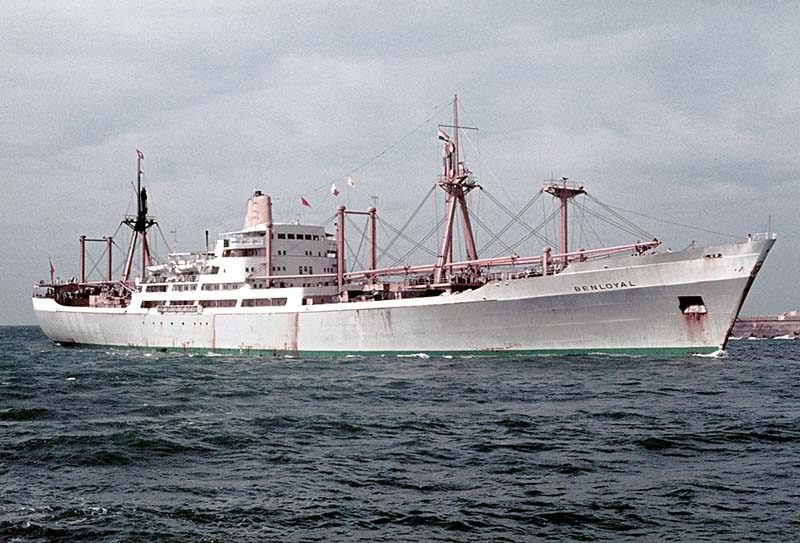
Design and Specification
The design of Benloyal included six large holds and seven hatches, the seventh being on the poop deck, and spacious ‘tween decks for the carriage of general cargo. There were upper and lower ‘tween decks in the four forward holds but only upper ‘tween decks in the two aft holds. Four compartments of 14,800 cubic feet in number four lower ‘tween deck were fitted for the carriage of refrigerated cargo, with good insulation maintaining a temperature of zero degrees under tropical conditions. Three tanks for the alternative carriage of latex or general cargo were fitted in number one hold and aft of number six ‘tween deck (port and starboard), and four tanks for the carriage of edible oil were fitted at the tunnel sides of number five hold. An unusual and important cargo carried by Ben Line was condensed milk, with certain compartments reserved for its carriage at an ideal temperature. The four refrigerated cargo spaces as well as the four edible oil tanks in number five hold were all fitted with a separate air heating and circulating system. An extraction fan withdrew air from the spaces and passed it over a heater before returning it to the tank or compartment. Thus, the temperature could be gradually raised during the voyage to suit conditions at the port of discharge.
Benloyal was named after a mountain of 2,506 feet in height located near Kyle of Tongue on the northern coast of Scotland in Sutherland. The principal dimensions of Benloyal were length overall of 549.5 feet, moulded beam of 71.0 feet, depth to upper deck of 44.6 feet, and loaded draft of 30.0 feet. The cellular double bottom was subdivided for the carriage of fuel oil, fresh water and water ballast. Number one double bottom tank carried water ballast and was deeper than the other compartments, and was equipped with electro rust-proofed cathodic protection, employing anodes of a type specially developed for use in double bottom tanks. Numbers 2, 3 and 4 double bottom tanks carried fuel oil or water ballast, while number five double bottom tank formed a deep tank beneath the engine room, with settling tanks located in the engine room. Number six double bottom tank carried feed water, while number seven tank carried fresh water or water ballast. In addition, tunnel side tanks carried fresh water at the forward end of number six hold, and the fore and aft peak tanks also carried water ballast.
Six special mechanical ventilating units were coupled to a central air drying installation to ventilate the holds, special cargo spaces, and the latex and edible oil tanks. These were capable of changing the air at 38,000 cubic feet per minute, and were arranged to supply, recirculate or exhaust the spaces as required. The operations of the ventilating units were shown on a central recorder, which showed the dewpoints of the air in the holds and the outside air temperature. The galley, laundry, drying room and storage rooms were served by centrifugal fans in order to minimise excess heat in tropical conditions. Sewage disposable was via two vertical pumps with automatic starting apparatus.
The weather deck hatchways were closed by means of MacGregor watertight steel covers of the single pull type. The long fo’c’stle of length 71 feet covered number one hold, the upper deck covered number four hold and the machinery spaces, and there was a short poop of length 41 feet. Among the striking features of Benloyal were her streamlined superstructure and unusual aerofoil section funnel, the latter designed by wind tunnel tests by the National Physical Laboratory in order to minimise soot falling on the aft decks.
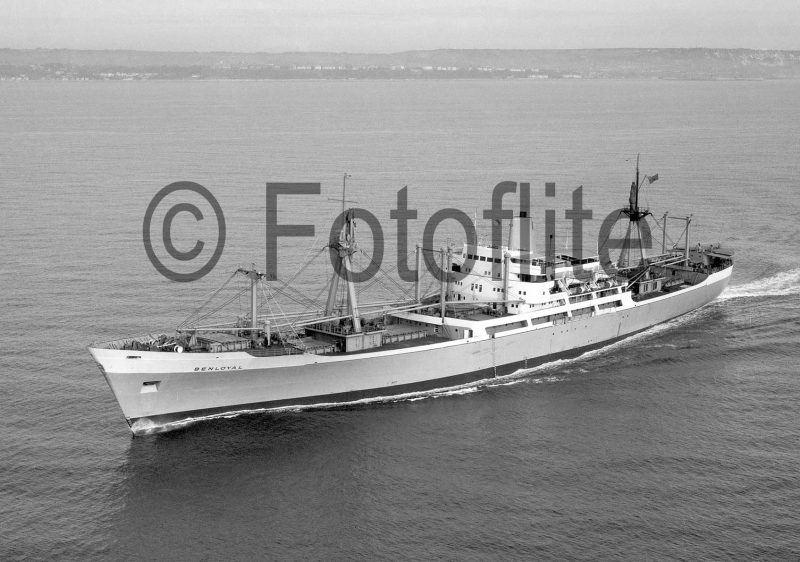
Single berth cabins were provided for each crew member of the deck, engineering and catering departments in the long bridge deckhouse on the Upper Deck. Forward of number four trunked hatchway there was a large crew recreation room for the sixty crew members, with toilets provided on the centreline between the engine and boiler exhaust casings. The Navigating and Engineering Officers were accommodated in the deckhouse on the Bridge Deck, the Chief Engineer having a three room suite. At the aft end of Bridge Deck was the air conditioned Dining Room with seating capacity for 33 persons, with a new lighting system that diffused the illumination from fluorescent tubes by means of square acrylic plastic panels. The passenger accommodation for ten passengers was arranged in an unusually shaped deckhouse at the forward end of Boat Deck in four two-berth and two single-berth cabins. The air conditioned Passenger Lounge was arranged centrally between their cabins, and at the aft end of the deck was a spacious air conditioned Smoking Room entered either from the outside deck or from an internal stairway from the Dining Room entrance hall.
The beautiful furnishings of the passenger public rooms and cabins were chosen by Lady Thomson, wife of Sir Douglas Thomson (Bart), who along with Edward Gordon Thomson, were two of the partners of William Thomson and Co. Ltd. The Dining Room was panelled in dark wood with curtains on either side of the windows, and a portrait of H. M. The Queen above the main table seating nine, with the other diners seated at tables for six, four and two. The Smoking Room was beautifully furnished with dark carpets and light coloured fabric easy chairs surrounding elegant and slim tables to give a room for relaxation. The four two berth passenger cabins had one side elegantly curved and fitted with a wide window as well as a large dressing table with mirror above, comfortable sofa and easy chairs, and raised beds. The Passenger Lounge was furnished with dark carpets, light coloured fabric easy chairs and comfortable sofas, and elegant occasional tables usually decorated with flowers in tall glass vases. Ventilation and heating to the passenger public rooms and cabins was provided by two units capable of maintaining an even indoor temperature of seventy degrees Fahrenheit via standard punkah louvres.
The Master’s House was elliptical in shape above the Boat Deck and contained a suite of three rooms for his use in his dayroom, bedroom and office, and nearby were the cabins with en-suite facilities for the Chief Officer and Pilot. The Radio Officer was accommodated on the Navigating Bridge, where he could be in close proximity to the radio room. The steering console position, Marconi Radiolocator radar, long range direction finder, echometer and bearing indicator were situated at the rear of the wheelhouse, with the port and starboard engine telegraphs situated close to the sliding doors giving quick access to the bridge wings. The wheelhouse floor was wooden and the wheelhouse front was fitted with three Beclawat wide vision windows of dimensions four feet wide by 2.5 feet high and were of the watertight vertically sliding design, and were flanked on either side by a fixed window of similar size and fitted with the important and vital Kent circular clear view screen.
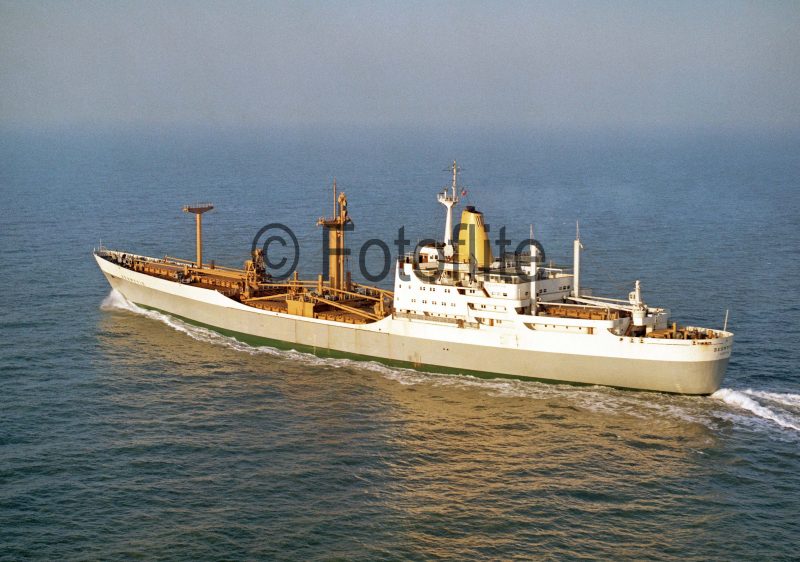
Cargo Handling and Deck Equipment
A comprehensive outfit of cargo handling equipment was supplied to Benloyal, including between numbers two and three hatches a Hallen bipod mast accommodating a seventy tonne heavy lift derrick, plus two of ten tonnes and two of five tonne capacity. The mainmast was also of the Hallen bipod type and accommodating a fifty tonne heavy lift derrick and four of ten tonne capacity. Three strong preventer stays were fitted on the foremast and two on the mainmast to ensure heavy lifts above twenty tonnes could be successfully lifted. Samson posts were provided between numbers one and two holds, and also above number four hold and in front of the bridge front, and also at the aft end of number six hold. The hatches varied in size from 36.6 feet by 21.0 feet down to 20.3 feet by 21.0 feet, with the small hatch on the poop being only 17.0 feet by 10.0 feet. The electric cargo winches were provided with separate contactors and remote controllers and were located on the tops of the winch houses at each mast, or at deck level. Benloyal was among the first British cargo-liners to be fitted with twin five tonne electric cranes on either side of number five hatchway.
Steering was via a Simplex balanced rudder of streamlined section, and together with the steering gear, sternframe, backpost and rudder stock provided a reliable electro-hydraulic method of steering the vessel. Benloyal was given three bower anchors and one stream anchor together with all of the necessary chains and cables. The cables comprised 330 fathoms of 2.5 inch electrically forged high tensile steel, and in addition 45 fathoms of 2.5 inch cable shackled in 15 fathom lengths, all hauled by a Clarke Chapman electric windlass. The windlass was of the separate bedplate type, having the motive power installed on the deck below the windlass, and was fitted with three cable lifters, the centre unit being used for buoy mooring. Clarke Chapman roller bow-stoppers were fitted at the head of the hawse pipes and were snugly stowed in anchor pockets within the shell.

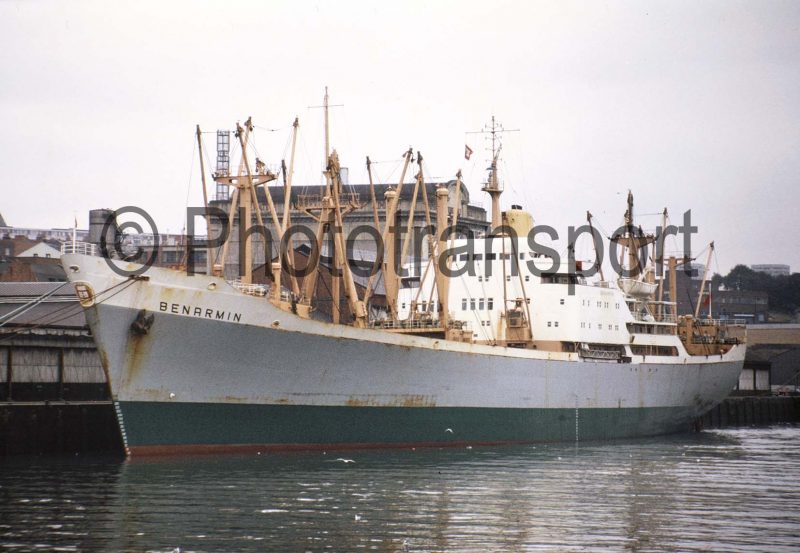
The aft moorings consisted of two five tonne electric warping winches situated on the poop deck, and also operated the aftermost pair of cargo derricks serving number seven hatch on the poop deck. Deck castings, fairleads and mooring pipes, and four plastic hull lifeboats housed in Welin single pivot torque, gravity deck davits were all standard equipment, with the addition of one boat being motor driven and all having space for forty one persons. Fire fighting equipment consisted of a smoke detecting and fire extinguishing system, and a diesel driven fire pump to meet Ministry of Transport requirements. Fourteen watertight doors were fitted.
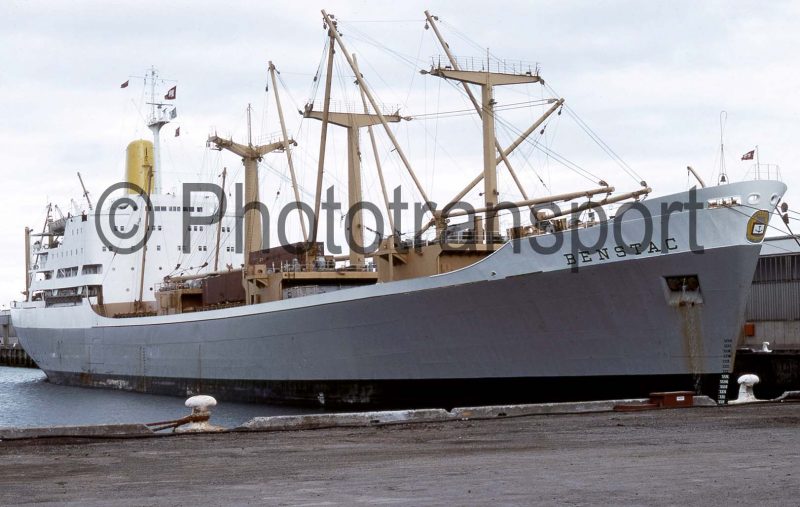
Main Propelling and Auxiliary Machinery
Steam for the set of David Rowan built Pametrada geared turbines at 600 pounds per square inch and a temperature of 850 degrees Fahrenheit was raised by two watertube boilers of the Babcock & Wilcox integral furnace superheat type constructed under licence by the engine builders. Fuel oil was burned under a closed system of forced draught, with the oil burning equipment also supplied by Babcock & Wilcox, while the twin forced draught and twin induced draught fans were supplied by James Howden & Co. Ltd. The main propelling machinery of the high pressure and low pressure steam turbines drove a single Novoston alloy propeller through double reduction gearing.

The turbines were controlled in the engine room from a centrally located console, which carried the main manoeuvring wheels and essential instruments. The high pressure ahead turbine was of the impulse type and the low pressure ahead turbine of the double flow reaction type. Astern power of 8,400 shaft horse power was provided by a high pressure impulse wheel housed in a separate housing and overhung at the forward end of the high pressure ahead turbine, and also by a low pressure astern turbine incorporated in a separate casing in the low pressure ahead turbine.
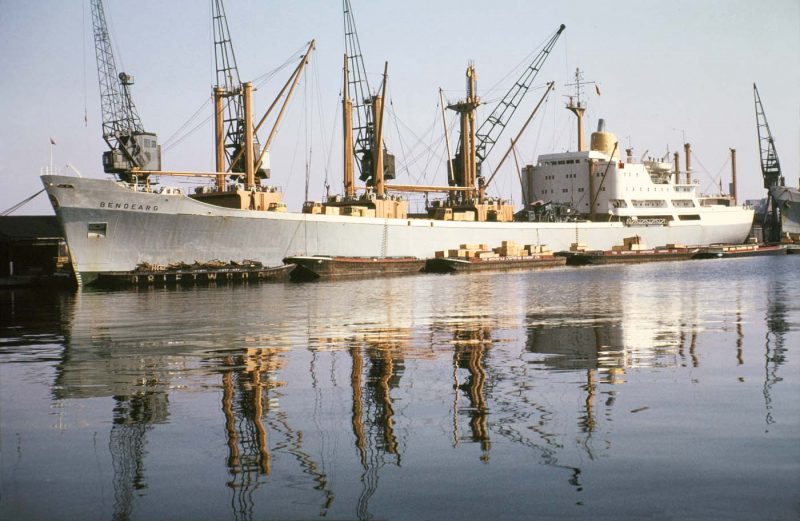
Electricity was provided by four Ruston diesel engines flexibly coupled to four Allen generators each of 220 kilowatt to give a 220 volt DC electric system. A DC electrical system was used to provide easier speed control on cranes, derricks and winches than that provided by an AC system. Ventilation of the engine room was via twin Aerex 35.5 inch diameter axial flow fans, and four fans of 30.0 inch diameter, giving a total of 80,000 cubic feet of air change per minute. Essential engine room pumps and auxiliaries included three lubricating oil pumps, lubricating oil centrifugal purifiers and coolers, a closed feed water system for the boilers with extraction pumps and turbo feed pumps, a vertical saturated steam generator, twin auxiliary steam driven pumps for the auxiliary oil fired boiler, and an electrically driven vertical fuel oil transfer pump. Electrically driven air compressors, main circulating pumps, and many other pumps for a variety of uses including ballast, fire and bilge, general service, diesel oil transfer, refrigerating, and fresh and salt water services were also fitted.
Benloyal and her Similar Fast Ben Line Cargo-Liners
The trials of Benloyal did not go as well as planned, as when maximum full power was applied for the high speed run, the thrust block seized on the high pressure turbine, necessitating major repairs to the rotor of this turbine. In fact, the newly completed rotor of the high pressure turbine of Bengloe, the second ship of the series, was used for this major repair of replacing the damaged rotor. In addition, five hundred tonnes of cement ballast was placed in her bottom after her trials to maintain her full stability, and this stability problem was also the reason why the extended forward part of the superstructure above number four hold was dispensed with in her later near sisters.
Ten further fast cargo-liners were built at the Scotstoun yard on the Clyde for Ben Line until the last, Benlawers, was completed in June 1970. Benloyal was joined by three similar but not exact sisters in Bengloe in June 1961, Benvalla in September 1962, and Benarmin in July 1963. Variations on the theme of Benloyal included the number and positioning of Hallen bipod masts and Samson posts, shape of funnels, and length of fo’c’tle and poop, with the extended long bridge deckhouse above number four hold removed in her three later similar vessels. Benvalla and Benarmin were powered by ten cylinder twin single acting Sulzer diesel engines of 15,000 bhp to give their fast service speeds of twenty knots. Bendearg of June 1964 and her improved later sister Benstac of January 1968 introduced a five hold five hatch fast type with the superstructure moved to the ‘three quarters aft’ position to give four clear holds forward served by eighteen derricks including a 75 tonne heavy lift derrick.
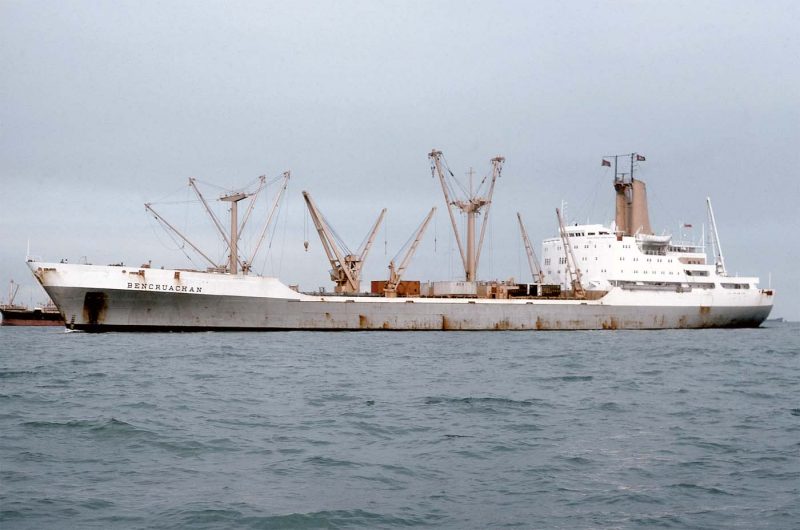
Benledi was the first of a new class of three fast cargo-liners of 13,785 dwt when she was completed at Scotstoun in June 1965, followed by her sisters Benwyvis in December 1966 and Benalbanach in July 1967. The trio were developed from the Benloyal design, and were powered by nine cylinder Sulzer diesels manufactured by the nearby Barclay, Curle yard to give 20,700 bhp and service speeds of 21.5 knots. Benledi made her fastest outward voyage to Singapore in only 16 days, 15 hours and 53 minutes to the anchorage off the port. Their four holds and five hatches, the aft hatch being small and just behind the funnel, were served by ten derricks including a heavy lift derrick of 75 tonne capacity, and six electric cranes. They carried a dozen passengers, and had refrigerating capacity and tanks for the carriage of latex. Their principal measurements were length of 563.0 feet and thus fourteen feet longer than Benloyal, moulded beam of 75.0 feet and thus four feet wider than Benloyal, and a loaded draft of 34.0 feet, and thus four feet deeper than Benloyal.
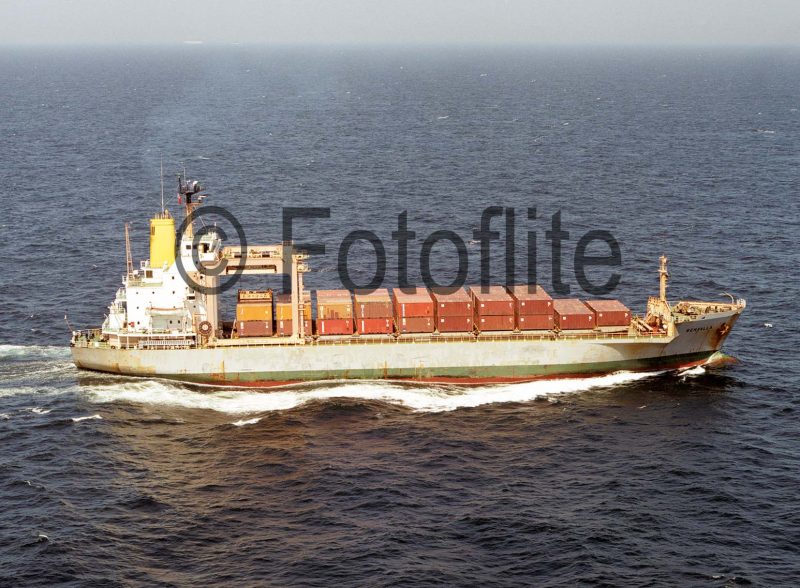
The fast 21.5 knot service speeds of the Benledi trio came in very useful after the closure of the Suez Canal in October 1967, but the much longer voyages via the Cape of Good Hope necessitated the purchase of Ellerman Line and P. & O. cargo-liners to help out with the longer voyage times to and from the Far East. The last pair of fast Ben Line cargo-liners from the Scotstoun yard were Bencruachan of 14,890 dwt in September 1968, and Benlawers of 14,750 dwt in June 1970. This pair featured part container capacity, with six derricks and six electric cranes on Bencruachan, and only two derricks and six cranes on Benlawers, but all able to lift containers. Bencruachan was twin funnelled with the funnels side by side and connected by a steel stay between them, she suffered the indignity of losing her propeller on the measured mile off Arran during her full power speed trials. When Benlawers was delivered, she joined a much bigger Ben Line fleet of 33 cargo-liners, however very large container ships were on order for the TRIO container service to the Far East of British, German and Japanese shipping companies.
Ben Line Containers (BLC) was formed in March 1970 with 80% ownership to Ben Line, and 20% ownership to Ellerman Line, but this also signalled the impending ‘beginning of the end’ for the relatively new fleet of eleven twenty knot cargo-liners from the Scotstoun yard. The Benledi trio were sold off to Italia Line in October 1972 to be renamed as Da Noli, Da Recco and Da Verrazano, and Benvalla and Benarmin were sold off to the China Ocean Shipping Corporation (COSCO) at the same time to become Yichun and Yong Chun respectively. Yong Chun was dry docked at Wallsend for the change of ownership, and was later broken up in China in October 1992. Yichun was renamed Hua Chun in 1977 and was broken up in Jiangsu in China in 1985. However, Benloyal, Bengloe, Bendearg, Benstac, Bencruachan and Benlawers sailed on for Ben Line.
Bencruachan needed the fitting of a new bow at the RDM yard in Rotterdam after being hit by a freak wave on 3rd May 1973. Capt. Sinclair was on his last voyage before retiring when she sailed from Singapore, but had to divert to Medan in Sumatra to land a sick crew member with appendicitis, and also to Colombo for bunkers. She was thus behind schedule and was travelling at 21 knots in a heavy gale some 100 miles north east of Durban at 2015 hours when she was hit by a rogue wave of up to one hundred feet in height. She went deep into the wave and the weight of the water on the fo’c’stle dislocated the bow for up to 30 to 40 metres of the fo’c’stle. The actual point where the bow folded was a tank full of latex, which remained watertight and probably saved the ship. The impact with the wave was so severe that her Foster Wheeler boiler was forced back almost three inches in the engine room. The bow damage was severe, with number one hold torn open and her bow fractured and drooped downwards by at least eight degrees from the designed position. The passengers were taken off by helicopter to Durban and then flown home, and she was towed into Durban stern first for temporary repairs, and then made her way slowly to Hull for discharge and then on to Rotterdam for permanent repair.
Benloyal arrived at Inchon on 16th June 1978 for breaking up, but her demolition did not begin until six months later in January 1979. Bengloe arrived for breaking up at Hong Kong on 29th July 1978, with Bencruachan aground in the Bitter Lakes in the Suez Canal on 7th August 1978 on a voyage from Liverpool to Yokohama, and it was two weeks later before she was refloated. This left only four in service of the original eleven Scotstoun built twenty knotters in the Autumn of 1978 in Bendearg, Benstac, Bencruachan and Benlawers in Ben Line service. However, Benlawers departed from Ben Line service in October 1978 on her sale to Zepconcorde Inc. of Singapore to become Globe Express.
The final scene of the last trio of this time honoured saga of fast Ben Line cargo-liners sailing for the Far East was played out during 1980/82. Bencruachan was sold for breaking up at Kaohsiung, where she arrived on 3rd May 1980. Bendearg was sold in April 1981 to Tung Chiao Shipping (Pte) Ltd. of Singapore and was renamed New Panther, and was broken up in China four years later. This left only Benstac in service on her long term charter to Barber Blue Sea for their Round the World service via South American and Far East ports, until she was sold in 1982 to Greek owners and renamed as John P. She lasted only three more years in service, until she sprang a leak on 17th April 1985 400 miles east of Rio Grande while carrying grain, and sank off Southern Brazil in position 32°07′ South, 44°08′ West around midday. She had severe cracks in the starboard shell plating of the engine room, and her crew of 25 was picked up by the cargo ship Ibn Malik of the United Arab Shipping Company (UASC), which continued on her voyage to Buenos Aires, and where all of the crew of the former Benstac were brought ashore.
Da Recco, the former Benwyvis, was severely damaged by fire on 4th June 1979 while laid up at La Spezia alongside the Italia Line liner Leonardo da Vinci. She was towed clear but was later condemned and broken up locally. Da Noli, the former Benledi, arrived at Chittagong from Constantza on 30th June 1987 as Bello, but ran aground there two months later, and was not finally broken up there until 1993. Da Verrazano, the former Benalbanach, was laid up for some time in Piraeus Roads as Bill from June 1987, and was then broken up at Alang in India in October 1988.
Benlawers became the Italian livestock carrier Uniceb in 1981 and was employed on the route from Australia to the Persian Gulf, but caught fire in her engine room on 2nd September 1996, with the fire quickly spreading to her accommodation and holds in the Indian Ocean in position 5°12′ South, 65°19′ East, and she foundered soon afterwards.
Postscript
Benloyal and her later ten very similar Ben Line cargo-liners were the embodiment of the best in British liner shipping from 1959 until 1982. Ben Line continued in existence with bulk carriers, ships and drilling rigs replacing cargo-liners. Seven ore carriers and bulk carriers were purchased in December 1976 from the Sheaf Steam Shipping Co. Ltd. and 50% of the Bamburgh Shipping Co. Ltd. of Newcastle, an offer of 115 pence per share for all of the shares being accepted. The Newcastle company had been founded in 1906 by William Alfred Souter (later Sir), who had died in July 1963, and the offer was accepted by Douglas and David Souter. The remaining 50% of the Bamburgh Shipping Co. Ltd. was purchased from British Steel in August 1980, when the Ben Line fleet consisted of five container ships, four cargo-liners Bencruachan, Benstac, Benarty and Bendearg, six bulk carriers including the new Panamax type Benhope from Sunderland Shipbuilders Ltd., three chemical tankers, three managed Aframax tankers, and three drillships.
In July 1992, Ben Line sold their three large container ships on the Far East service to bankers, who bareboat chartered them to the East Asiatic Company (EAC) of Denmark, who also took over their management. A few months later, the feeder container ship Benvalla and the last Ben Line ship was sold to Singapore owners, but she carried on in the South East Asia feeder container services for which she had been designed and built in 1979 by Mitsubishi Heavy Industries in Kobe. One oil rig remained and was renamed Bennevis in 1996 as the only marine asset of the Ben Line Group Ltd. and the Atlantic Drilling Ltd., which continued drilling for a few more years.
Today, the Ben Line business is focussed on agency operations through Ben Line Agencies (BLA). These include shipbroking, liner agency, port agency, project logistics, offshore support, international freight forwarding, port representation, container and tank leasing, P. & I. Club agency representation and ship survey work. Ben Line now has 116 offices around South East Asian countries and the Far East with two thousand employees.
Benloyal and the fast twenty knot Ben Line cargoes carried all manner of cargoes homeward including latex, edible oils, rubber, spices, rice, sago, tapioca, timber, tin ores, maize, textiles, machinery, cement, paper, processed food, fertilisers, hemp, copra products, tea and coffee, flour, pepper and jute. As Singapore and South East Asian countries became more sophisticated, they also carried cameras, watches, transistor radios, electrical and manufactured goods of all types to Europe. Ben Line Steamers Ltd. had been formed in 1919, however William Thomson had begun to manage and trade ships in 1847, and had established shipping links with Singapore in 1859 when the sailing ship Araby Maid of 365 grt had sailed on its first exploratory voyage to Singapore and the Far East. Ben Line Agencies (BLA) has a big presence in South East Asia today, 180 years after the first Thomson sailing ship Carrara was completed in 1839 for the marble trade from Carrara in Italy to Leith. The huge BLA network in South East Asia will also ensure that there will be a celebration of the bicentenary of the Thomson and Ben Line dynasty.


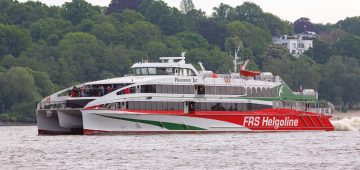



Comments
Sorry, comments are closed for this item